|
|
|
Sort Order |
|
|
|
Items / Page
|
|
|
|
|
|
|
| Srl | Item |
| 1 |
ID:
110004


|
|
|
|
|
| Publication |
2012.
|
| Summary/Abstract |
This article examines the factors that have contributed to the end of the Red Army Faction (RAF), and places particular emphasis on the causes and characteristics of individual disengagement of RAF members from the armed struggle. It discusses the evolution, ideology, and decline of each of the three generations of the RAF. The article's contribution is twofold. First, by assessing both contextual- and individual-level factors that led to the group's demise, the article bridges two approaches to analyzing the demise of terrorist organizations-the literature on how terrorism ends and why individuals disengage from terrorism. Second, the article helps build a growing empirical body of work on the demise of terrorist groups that can be used to confirm, challenge, or refine existing hypotheses on how terrorism ends, while formulating new ones. The article concludes that different factors contributed to the decline of each subsequent generation of the RAF. Successful German police efforts played a critical role in thwarting the RAF's first generation. Lack of public support and recruits, due in large part to an escalation of terrorist violence, hastened the decline of the second generation of the group. The third generation suffered from serious interorganizational strife, exacerbated by a government initiative that offered to release those RAF members from prison who renounced terrorism.
|
|
|
|
|
|
|
|
|
|
|
|
|
|
|
|
| 2 |
ID:
123395
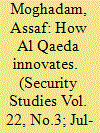

|
|
|
|
|
| Publication |
2013.
|
| Summary/Abstract |
Innovative terrorist organizations pose exceptionally dangerous threats because of their potential to surprise declared enemies, inflict heavy costs upon them, and set new trends that other militant groups seek to emulate. Despite this importance, researchers have shed little light on where terrorist innovation originates. Although military innovation scholars have emphasized the importance of both top-down and bottom-up innovation, the few existing studies on terrorist innovation have acknowledged the importance of the terrorist leadership but largely ignored the role played by middle- or lower-ranking operatives in the innovation process. This study examines the planning of the September 11, 2001 attacks and finds that, contrary to the predominant claims on terrorist innovation, the 9/11 attacks featured both top-down and bottom-up processes of innovation, with the latter including a critical role played by an independent terrorist entrepreneur. Theoretically, the findings suggest that the conventional wisdom of the predominance of top-down innovation in terrorism is dependent on a problematic assumption, namely that terrorist groups are centralized, hierarchical, and localized entities. As more terrorist groups adopt decentralized structures, they are increasingly likely to display multi-directional processes of innovation. The study has important implications for counterterrorism policy. It suggests that thwarting the most innovative terrorist groups requires targeting senior- and middle-management operatives of the group itself and expending greater effort at apprehending independent terrorist innovators with fluid organizational affiliations. A mix of offensive and defensive counterterrorism strategies, coupled with greater international cooperation, is critical to achieving this goal.
|
|
|
|
|
|
|
|
|
|
|
|
|
|
|
|
| 3 |
ID:
162741


|
|
|
|
|
| Summary/Abstract |
This article examines the current state of the global jihad movement and offers reflections on its likely trajectory in the foreseeable future. It concludes that while the global jihad temporarily has been set back by the relative decline of the Islamic State, the movement overall benefits from al-Qaeda's regeneration; its ongoing ideological appeal; and its structural decentralization. In the next years, the movement likely will continue to evolve from its current bipolar structure toward an increasingly multipolar entity. Furthermore, it argues that the future jihadi movement will contain a large number of jihadi actors whose relationships will span cooperative, competitive, or mixed engagements, with implications for the movement as a whole. The article highlights several challenges for counterterrorism, including dealing with a complex movement structure; radicalization; socio-political disenfranchisement; the counter-response of societies targeted by jihadist violence; and technological changes. The article concludes with an assessment that in the next two to five years, the global jihad will remain a potent, although not an existential, threat.
|
|
|
|
|
|
|
|
|
|
|
|
|
|
|
|
| 4 |
ID:
076660
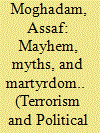

|
|
|
| 5 |
ID:
085681
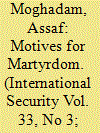

|
|
|
|
|
| Publication |
2009.
|
| Summary/Abstract |
Suicide missions made their modern debut in 1981. In recent years, however, they have witnessed an unprecedented increase according to several indicators, including number of attacks, number of organizations conducting these attacks, number of countries targeted, and number of victims. Existing explanations, including the occupation and outbidding theses, cannot account for the dramatic increase and spread of suicide attacks. A combination of quantitative and qualitative methods, including analysis of a data set of 1,857 suicide attacks from December 1981 through March 2008, suggests that two interrelated factors have contributed to the "globalization of martyrdom": al-Qaida's evolution into a global terrorist actor and the growing appeal of its guiding ideology, Salafi jihad. As localized patterns of suicide missions have given way to more globalized patterns, states must rethink their counterterrorism strategies. At the same time, because Salafi jihadist groups tend to target Muslims, moderate Muslims and nonviolent Salafists must take the lead in challenging these groups.
|
|
|
|
|
|
|
|
|
|
|
|
|
|
|
|
| 6 |
ID:
054903
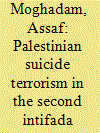

|
|
|
| 7 |
ID:
174118


|
|
|
|
|
| Summary/Abstract |
Studies of conflicts involving the use of surrogates focus largely on states, viewing the relationship between sponsors and proxies primarily as one in which states utilize nonstate actors as proxies. They have devoted far less attention to sponsor-proxy arrangements in which nonstate actors play super-ordinate roles as sponsors in their own right. Why and how do nonstate actors sponsor proxies? Unlike state sponsors, which value proxies primarily for their military utility, nonstate sponsors select and utilize proxies mainly for their perceived political value. Simply put, states tend to sponsor military surrogates, whereas nonstate actors sponsor political ancillaries. Both endogenous actor-based traits and exogenous structural constraints account for these different approaches. An analysis of three case studies of nonstate sponsors that differ in terms of ideology and capacity—al-Qaida in the Arabian Peninsula, the People's Protection Units in Syria, and Hezbollah in Lebanon—confirms this argument, but also suggests that the ability and desire to control proxies varies with the sponsor's capacity. High-capacity nonstate sponsors such as Hezbollah behave similarly to state sponsors, but remain exceptional. Most nonstate sponsors are less dominant, rendering the relationships to their proxies more transactional and pragmatic, and ultimately less enduring than those of state sponsors and their clients.
|
|
|
|
|
|
|
|
|
|
|
|
|
|
|
|
| 8 |
ID:
075026
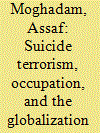

|
|
|
|
|
| Publication |
2006.
|
| Summary/Abstract |
This article offers a three-pronged critique of Robert A. Pape's book Dying to Win. The first section of the article highlights problems related to the book's definition of key concepts, its assessment of existing research on suicide terrorism, and its presentation of data. The next section challenges the book's argument that suicide attacks have a high success rate of 54 percent. The alternative analysis offered here arrives at a significantly lower success rate of 24 percent. The last section argues that Pape exaggerates the link between occupation and suicide terrorism, especially with regard to the case of Al Qaeda. In this context, a distinction between traditional (localized) and contemporary (globalized) patterns of suicide attacks is introduced. It is argued that the occupation thesis may help explain the traditional (localized) pattern of suicide attacks, but falls short of illuminating the causes of the contemporary "globalization of martyrdom."
|
|
|
|
|
|
|
|
|
|
|
|
|
|
|
|
|
|
|
|
|